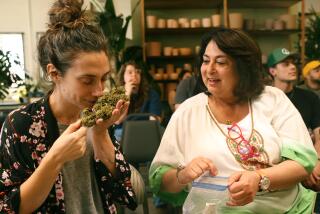Herbs Offer Tasty Reward for the Plant Lover
- Share via
A manageable herb garden on a kitchen windowsill may be just the right touch for those who have a desire to putter among plants but shy away from the thought of getting down and dirty in the back yard.
Cultivating herbs indoors is almost as easy as growing house plants, but much more rewarding for the home cook, who can delight in plucking an aromatic leaf from an herb plant just steps away from the stove to add verve to any culinary creation.
“There is nothing like having fresh oregano . . . to put in a spaghetti sauce,” said Barbara Ellis, garden editor at Rodale Press Books in Emmaus, Pa. “There is something that’s lost in the purchased herbs. The fresh stuff that you’ve grown yourself is infinitely better.
“Keeping them convenient is important for any kind of herb,” she added. “When you are in the middle of cooking, you are not going to walk out to the back 40 for some herbs.”
In addition to convenience and fresh bursts of flavor, indoor herbs are ornamental and can add a wonderful potpourri of fragrance to a kitchen.
Kitchen herb gardens are a perfect alternative for apartment dwellers who don’t have the option of back-yard cultivation. An indoor garden also helps those with extensive outdoor plantings during the spring and summer, as the indoor herbs will survive the winter months.
Rodale’s Illustrated Encyclopedia of Herbs, edited by Claire Kowalchik and William H. Hylton (Rodale Press, $24.95), urges one cardinal rule when planting a winter kitchen garden:
“Make sure you grow enough. One perky little parsley or bright green basil may cheer you up, but it is unlikely to go far toward perking up winter salads or spaghetti.”
Herbs that do well indoors include basil, bay, chives, garlic chives, marjoram, mint, oregano, parsley, rosemary, sage and savory.
Growing herbs indoors means dealing with seven major aspects of plant culture--light, temperature, air circulation, soil, fertilization, water and pests.
Most herbs thrive on light, at least five hours of direct sunlight a day, but natural sunlight can be supplemented or replaced with fluorescent light. Plants should be turned on windowsills regularly to keep them shapely.
Herbs like temperatures on the cool side--daytime temperatures of 65 degrees and nights at 60 degrees.
Herbs also are sensitive to dry, stagnant air, the kind found in centrally heated houses. Such conditions can promote fungal diseases and insect infestations. The encyclopedia suggests cracking a window in an adjoining room for better ventilation or setting pots on pebble-lined trays filled with an inch or less of water.
Use a soil mix with good drainage to pot herb plants. Ellis suggested you avoid actual garden soil because eggs laid by insects in the cold soil can hatch in the warmer indoor temperatures.
Herbs should be planted in pots that are four to six inches in diameter.
And be careful when fertilizing not to overdo it, Ellis said.
“You don’t want to encourage a lot of lush growth because when herbs grow too fast, they don’t have time to develop their intense flavor,” she said.
Herbs like regular watering but over-watering can produce root rot and other fungal diseases. Most herbs should be watered just when the soil surface starts drying out.
As far as pests go, it is written in the encyclopedia that while herbs do not often fall victim to infestations, dry indoor conditions can bring on the spider mites, whiteflies and aphids. A soap spray may be all that’s needed to keep such pests at bay.






